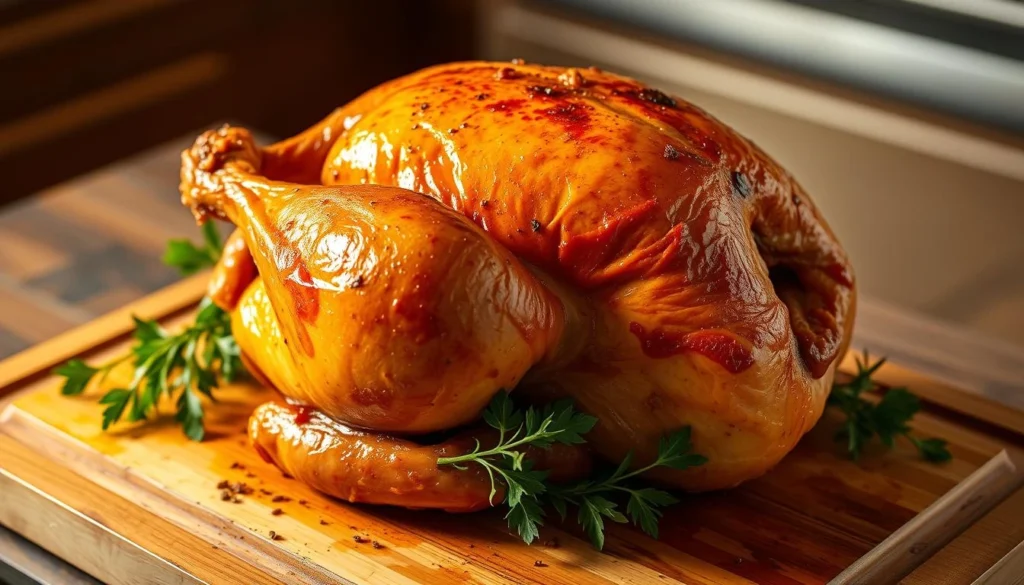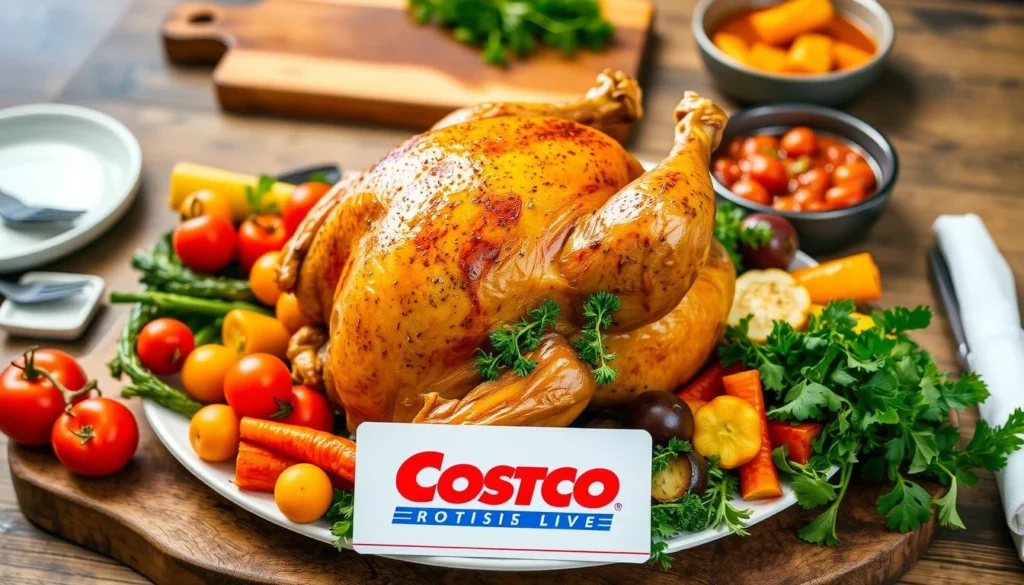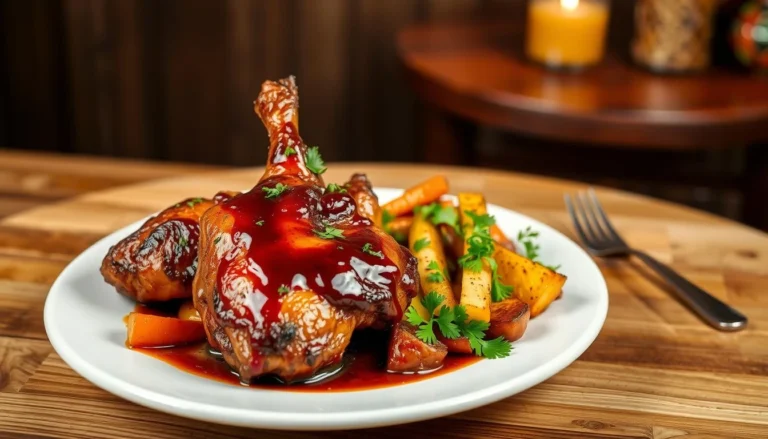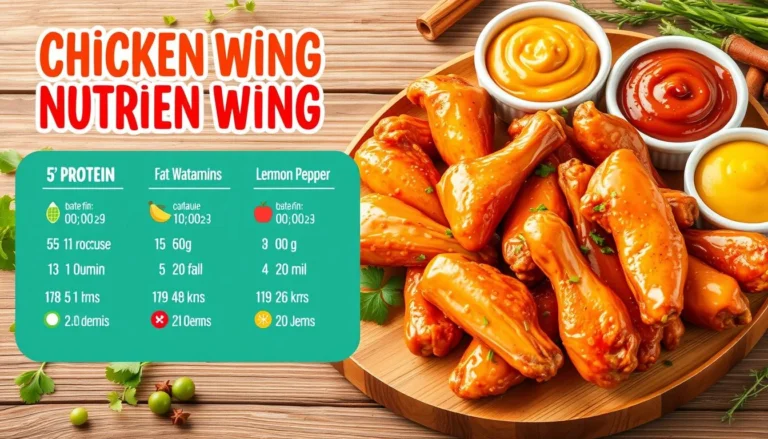Costco Rotisserie Chicken Nutrition: Complete Guide
Table of Contents
As a busy parent, finding tasty and healthy meals for my family is a big challenge. Costco’s rotisserie chicken has been a game-changer for us. It’s affordable and delicious, making it a favorite in many homes. But, have you thought about its nutritional value?
In this guide, we’ll look closely at Costco rotisserie chicken nutrition. We’ll cover calories, macronutrients, and health benefits. This guide is for anyone wanting to know more about this popular chicken. It’s perfect for those looking to improve their family’s diet or just curious about what they eat.
Key Takeaways
- Costco’s rotisserie chickens have been priced at $4.99 since 2009, despite the company’s willingness to lose $30 to $40 million per year to maintain this low cost.
- A Costco rotisserie chicken weighs approximately 3 pounds, offering exceptional value for the price.
- Costco’s rotisserie chickens are limited to a 2-hour shelf life for optimal taste and flavor, ensuring freshness.
- Rotisserie chickens are a popular and sustainable protein choice, with chicken surpassing beef as the most consumed protein in the United States.
- Costco’s rotisserie chickens provide a nutritious option, with a 3-ounce serving containing around 115 calories, 24 grams of protein, and 2.5 grams of fat.
Overview of Costco Rotisserie Chicken
Costco’s rotisserie chicken is a favorite for many. It’s affordable and easy to grab for a quick meal. At $4.99, it’s been a great deal since 2009. Costco makes 137 million of these chickens every year, showing how much people love them.
What Makes It Popular?
Costco’s rotisserie chicken is known for its quality and taste. The company has its own chicken plant. This ensures each chicken is top-notch. They weigh about 3 pounds, making them a great deal at $1.66 per pound.
Price Point and Value
Costco actually loses money on each chicken. But they sell them cheap to bring in customers. This strategy works well, making the chicken a big hit with shoppers.
| Retailer | Price | Weight | Price per Ounce |
|---|---|---|---|
| Costco | $4.99 | 3 lbs | $0.10 |
| Walmart | $5.97 | 2 lbs 4 oz | $0.22 |
Compared to Walmart’s chicken, Costco’s is a better deal. Walmart’s chicken costs $5.97 for 2 pounds, 4 ounces. Costco’s chicken is over 10 cents cheaper per ounce.
Nutritional Breakdown
Costco’s rotisserie chicken is known for its nutritional value. A 3-ounce serving has about 115 calories, 24 grams of protein, and 2.5 grams of fat.
The nutritional details change based on the chicken part and if the skin is on. For instance, chicken breast without skin has 194 calories, 38 grams of protein, and 5 grams of fat. Chicken thighs with skin have 305 calories, 30 grams of protein, and 20 grams of fat.
Macronutrient Breakdown
- Protein: Costco rotisserie chicken is packed with protein, great for your diet.
- Fat: The fat in Costco rotisserie chicken is moderate, mostly from the skin.
- Carbohydrates: Costco rotisserie chicken has almost no carbs, perfect for low-carb diets.
Both white and dark meat of Costco’s rotisserie chicken are rich in vitamins and minerals. They include B vitamins, selenium, zinc, copper, and phosphorus. Dark meat has twice as much iron as white meat.
Costco’s rotisserie chicken is a favorite for its quality and price. Knowing its nutritional facts helps you use it wisely in your meals.
Ingredient List
Costco’s rotisserie chicken is loved for its taste and convenience. But, it’s good to know what’s in it. This is especially true for those who care about their health.
Common Ingredients Used
Costco’s chickens have water, salt, sugar, and chicken broth. These help with flavor and moisture. But, there are also additives that some might not like.
- Sodium phosphate: This keeps the chickens fresh longer. But, it might be bad for people with kidney issues.
- Casein: A protein from milk that could help with weight and metabolism.
- Soy protein lecithin: A safe food additive for most, as it’s in small amounts.
Flavor Preferences and Seasonings
The chicken’s flavor comes from a secret spice mix. This makes it tasty and easy to eat. But, the seasonings add a lot of sodium, which is something to think about.
“Costco sells over 100 million rotisserie chickens annually, making it a widely popular and convenient option for families.”
Health Benefits
Costco’s rotisserie chicken is more than just a quick and affordable meal. It’s also packed with health benefits. It’s a lean source of protein, which is key for muscle repair and growth. Each 3-ounce serving has 22 grams of protein, making it great for boosting your protein intake.
This chicken is also full of B vitamins. These vitamins are important for energy, nerve function, and skin health. Eating this chicken can help you eat more home-cooked meals. This might reduce your need for unhealthy fast food and help you eat better.
Easy Meal Preparation
Costco’s rotisserie chicken is super convenient. It’s perfect for busy people and families who need quick, healthy meals. You can easily add it to salads, sandwiches, and casseroles. This makes meal planning easier and encourages healthier home-cooked meals.
High Protein Content
The chicken’s high protein content is great for those trying to manage their weight. The protein helps you feel full, which can stop you from overeating. This can help you stay on track with your weight goals in a healthy way.
“Rotisserie chicken is a lean, protein-packed option that can be easily incorporated into a variety of healthy meals. Its convenience and versatility make it a valuable addition to any well-rounded diet.”
Potential Drawbacks
Costco’s rotisserie chicken is loved for its convenience. Yet, there are some downsides to think about. The sodium in a 3-ounce serving is 460mg, way over the daily limit of 2,300mg. Too much sodium can lead to high blood pressure and other health problems.
The chicken’s skin also has a lot of saturated fat. This can raise LDL (bad) cholesterol levels. It’s a big concern for those with heart issues or watching their fat intake.
Sodium Content Considerations
The high sodium in Costco’s chicken comes from preservatives and seasonings. Store-bought chickens have about 331mg of sodium per 3-ounce serving. Homemade chickens have only about 62mg. This shows how processed foods can be higher in sodium.
Allergens and Sensitivities
Some people might react to the additives in Costco’s chicken. Ingredients like sodium tripolyphosphate (STPP) can increase sodium and phosphorus intake. This is a worry for those with kidney disease, heart issues, or weak bones. Always check the ingredients and consider your dietary needs.
While Costco’s chicken is convenient and affordable, it’s important to know its downsides. Understanding its nutritional content and possible allergens helps you enjoy it in moderation. This way, it can be part of a healthy diet.
Comparison to Other Rotisserie Chickens
Costco is a top choice for rotisserie chickens. But how does it compare to others like Whole Foods? Let’s explore the differences.
Whole Foods vs. Costco
Costco’s rotisserie chicken is a big deal, weighing three pounds for just $4.99. That’s about 10 cents per ounce. Whole Foods’ chicken is smaller, weighing 1-2 pounds for $8.99, or about $6.28 per pound.
Costco’s chicken has multiple additives like hydrolyzed casein and sodium phosphates. Whole Foods’ chicken is simpler, with just three items: chicken, salt, and pepper. Costco’s chicken might taste juicier, but Whole Foods’ is known for its purer, less processed taste.
Sam’s Club and Other Competitors
Sam’s Club offers a 2 pounds, 4 ounces rotisserie chicken for $5.97, or about 22 cents per ounce. Walmart’s chicken has 250 milligrams of sodium, 250 calories, and 19 grams of fat per 3-ounce serving. This is more than Costco’s 140 calories, 7 grams of fat, and 460 milligrams of sodium per 3-ounce serving.
Walmart and Costco both offer tasty rotisserie chickens. Costco’s is big and meaty, perfect for many meals. Walmart’s chicken is known for its flavor, juiciness, and character, even if it’s not as meaty as Costco’s.

Guidelines for Storage
Costco’s rotisserie chickens are a tasty and easy option. But, it’s key to store them right to keep them fresh and nutritious. Knowing how to refrigerate and freeze them can make this protein source even better.
Proper Refrigeration Techniques
Keep your Costco rotisserie chicken fresh by refrigerating it within two hours of buying. It can stay good in the fridge for 3-4 days. Make sure to put it in a sealed container or wrap it well in plastic to keep it moist and prevent other tastes from getting in.
Freezing Tips for Longevity
Freezing is a great way to keep your chicken longer. Just take the meat off the bones and put it in a tight container or freezer bag. This keeps the chicken’s taste and texture for up to 4 months. When you thaw and reheat it, make sure it gets to 165°F (74°C) to avoid food poisoning.
By sticking to these storage tips, you can enjoy Costco’s rotisserie chicken for a long time. Proper storage lets you get the most out of this affordable and versatile protein.
Meal Ideas with Costco Rotisserie Chicken
Costco’s rotisserie chicken is a great deal and easy to use in many meals. It’s perfect for quick dinners or adding to side dishes. You can make many tasty and healthy meals with it.
Recipes for Quick Dinners
Costco rotisserie chicken is quick to make into a delicious meal. Try a Creamy Lemon Chicken Pasta in 30 minutes. Or, make Chicken Stuffed Alfredo Shells for a cozy dinner.
For a simple dinner, try the Cheesy Caprese Chicken & Quinoa Casserole. It’s easy to make and full of flavor.
Creative Uses in Side Dishes
Use Costco rotisserie chicken in side dishes too. Add it to a Coconut Chicken Curry or a Chicken Chile Verde Stew. It makes any side dish more filling and tasty.
With Costco’s costco rotisserie chicken, you can make many dishes. From casseroles to tacos and soups, it’s a versatile and healthy choice. It saves time and tastes great.

Frequently Asked Questions
Costco’s rotisserie chicken is a hit, and people often have questions about it. Let’s answer some of the most common ones.
Is It Gluten-Free?
Costco’s rotisserie chicken is mostly gluten-free. The chicken itself doesn’t have wheat, rye, barley, or gluten. But, it’s smart to check the label for any gluten in seasonings or additives. If you’re gluten-sensitive, make sure to scan the ingredients before enjoying.
How to Reheat Properly
To keep your Costco rotisserie chicken juicy, reheat it right. Use your oven at 350°F (175°C) for 25 minutes. This ensures it’s hot and safe at 165°F (74°C). Don’t use the microwave, as it can dry out the chicken. Always eat or freeze it within 3-4 days.
Costco is making its rotisserie chicken packaging better. They’re switching to eco-friendly bags in the U.S., just like in Canada. This change makes the chicken more convenient and sustainable.
Conclusion: Making the Most of Costco Rotisserie Chicken
Costco’s rotisserie chicken is a great choice for quick, affordable meals. It’s high in protein and can be used in many ways. But, remember to watch the sodium and remove the skin to cut down on fat.
Using the chicken in healthy recipes with veggies and whole grains is a smart move. This way, it becomes a key part of a nutritious meal plan. It fits well with your health goals and dietary needs.
Think of Costco’s rotisserie chicken as a quick, healthy meal solution. It can be the main dish or a part of something new and tasty. Being aware of its nutritional value helps you enjoy it without guilt.
The rotisserie chicken from Costco is a perfect mix of costco rotisserie chicken nutrition and costco rotisserie chicken healthy convenience. It’s ideal for those who are always on the go but still want to eat well. Get creative with it and see how it can improve your cooking.
FAQ
Is Costco rotisserie chicken gluten-free?
Costco rotisserie chicken is usually gluten-free. But, always check the label for any gluten additives.
How should I reheat Costco rotisserie chicken?
To reheat, set your oven to 350°F (175°C). Cook for about 25 minutes, or until it reaches 165°F (74°C). Don’t microwave it to avoid drying out the meat.
What is the shelf life of Costco rotisserie chicken?
Costco rotisserie chickens last 2 hours at the store before being sold. Store it in the fridge within 2 hours of buying. It stays good in the fridge for 3-4 days.
For longer storage, take the meat off the bones. Freeze it in airtight containers or heavy-duty bags for up to 4 months.
How does the nutrition of Costco rotisserie chicken compare to other brands?
Costco’s chicken is cheaper, at $4.99, compared to Whole Foods’ $8.99. Sodium levels vary: Sam’s Club has 550mg per 3-oz serving, while Kroger and Whole Foods have less.
Nutritional values are similar, but preparation and additives can differ.
What are the health benefits of Costco rotisserie chicken?
Rotisserie chicken is a lean protein source, great for muscle repair and growth. It’s also rich in B vitamins, supporting energy and skin health.
It’s convenient for home meals, which can be healthier than fast food. Its high protein content helps with feeling full, aiding in weight management.
What are the potential drawbacks of Costco rotisserie chicken?
The main issue is its high sodium content. A 3-oz serving has 460mg, higher than some rivals. High sodium can lead to hypertension and other health problems.
The chicken’s skin has more saturated fat, which can raise LDL cholesterol. Some people might react to the processing additives.







